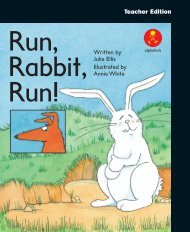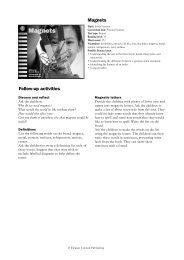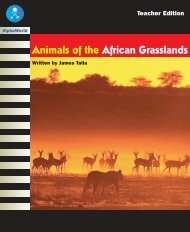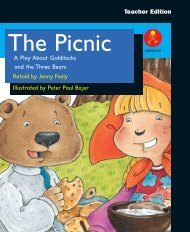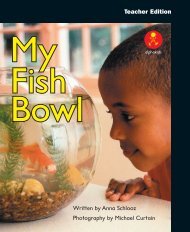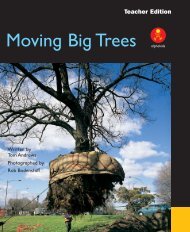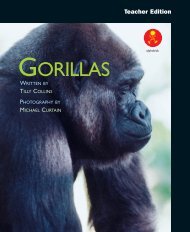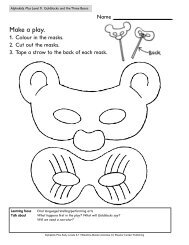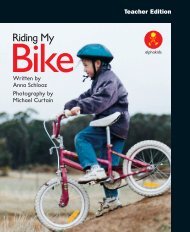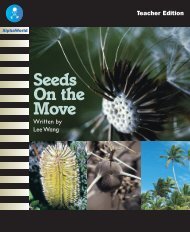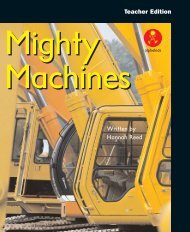Special Places at School
Special Places at School
Special Places at School
- No tags were found...
You also want an ePaper? Increase the reach of your titles
YUMPU automatically turns print PDFs into web optimized ePapers that Google loves.
Teacher EditionAlphaWorld<strong>Special</strong><strong>Places</strong><strong>at</strong> <strong>School</strong>Written byLee WangPhotography byMichael Curtain
Published edition© Eleanor CurtainPublishing 2004Text © Kerrie ShanahanPhotographs © EleanorCurtain PublishingFirst published 2004Apart from any fair dealing forthe purposes of study, research,criticism or review, aspermitted under the CopyrightAct of Australia, no part of thisbook may be reproduced byany process, or transmitted inany form, without permissionof the copyright owner. Wherecopies of part or the whole ofthis book are made under PartVB of the Copyright Act, thelaw requires th<strong>at</strong> records ofsuch copying be kept and thecopyright owner is entitled toclaim payment.Developed byEleanor Curtain PublishingText: Kerrie ShanahanConsultant: Susan HillDesigned byAlexander StittProduction byPublishing SolutionsPrinted in ChinaISBN 0 7253 3050 31 2 3 4 5 6 7 8 904 05 06?How to use this bookBefore reading: TalkthroughTalk through the book with the children. Encouragethem to predict the text from the cover and thepictures, and to think about the inform<strong>at</strong>ion provided.Direct the children’s <strong>at</strong>tention to aspects of the textth<strong>at</strong> may challenge them. Support the children as theydeal with these challenges by asking the Talkthroughquestions on each page.During reading: Observe and supportObserve the children as they read and encourage themto monitor their own reading. Help the children to usereading str<strong>at</strong>egies and cues to respond to readingchallenges th<strong>at</strong> arise in the text. Interruptions to thechild’s reading should be minimal and focused on aspecific learning need.After reading: A range of comprehensionand response activitiesTo develop children’s understanding of the text, selectfrom the activities found on page 12 and the insideback cover. These whole text, sentence and word levelactivities reinforce the teaching focus of this book.Assessment ideas are provided to assist with furtherteaching plans.Selected text fe<strong>at</strong>ures• Text written in the first person• Contents page• Section headings• Conclusion• Colour photographs support andextend the textVocabularyartist, building, chicken, coop, garden, hideand-seek,kitchen, sandpit, secret, special,vegetables
Setting the contextTell the children about your favourite place<strong>at</strong> school. Explain why you like it and wh<strong>at</strong>you do there. Invite the children to describethe places they think are special.Front coverShow the front cover.This book is called <strong>Special</strong> <strong>Places</strong> <strong>at</strong> <strong>School</strong>.Wh<strong>at</strong> sort of places might we hear about inthis book?Title pageTurn to the title page.Wh<strong>at</strong> inform<strong>at</strong>ion does the title page give us?Can you see these things on this title page?1
<strong>Special</strong> <strong>Places</strong> <strong>at</strong> <strong>School</strong> Pages 2–5?TalkthroughTurn to the contents page.This is the contents page.Read the section headings.Which place sounds the most interesting to you? Why?Turn to pages 4–5Does this school look like our school?Wh<strong>at</strong> is similar?Wh<strong>at</strong> are some differences?Observe and supportCan the children identify fe<strong>at</strong>ures of the text?Wh<strong>at</strong> is this page called?Wh<strong>at</strong> is the purpose of a contents page?How do you use a contents page?Where is the section heading on this page?How does a section heading help you to read a book like this one?2
<strong>Special</strong> <strong>Places</strong> <strong>at</strong> <strong>School</strong> Pages 6–9?TalkthroughTurn to pages 6–7Where are these children playing?Wh<strong>at</strong> sort of things can you do in a sandpit?Wh<strong>at</strong> toys are these children playing with?Turn to pages 8–9This section is called ‘The garden’. Why might a school have agarden?Wh<strong>at</strong> things do you think the children grow in their garden?Wh<strong>at</strong> would you learn by having a garden <strong>at</strong> school?Observe and supportDo the children use their knowledge of letter-soundrel<strong>at</strong>ionships to help solve problems?If any of the children are having difficulty reading a word, youcould say:Wh<strong>at</strong> letter does it start with? Wh<strong>at</strong> sound does th<strong>at</strong> make?Look <strong>at</strong> the ending of the word. Wh<strong>at</strong> does this tell us about theword?Wh<strong>at</strong> sort of word are we looking for here?Wh<strong>at</strong> would make sense?4
<strong>Special</strong> <strong>Places</strong> <strong>at</strong> <strong>School</strong> Pages 10–13?TalkthroughTurn to pages 10–11This section is called ‘The kitchen’.Wh<strong>at</strong> things do you think the children make in their kitchen?Wh<strong>at</strong> would they learn by doing this?Turn to pages 12–13This section is called ‘The secret garden’.Wh<strong>at</strong> sort of games might the children play in the secret garden?Wh<strong>at</strong> would you like to play in a secret garden?Observe and supportAsk the children to read aloud to you. Do they read the textfluently?I really like the way you read th<strong>at</strong>. It was clear and it was easy forme to hear every word.If needed, you may like to model fluent reading.Can you have a go now?Try reading so th<strong>at</strong> you sound like you are the girl talking.6
<strong>Special</strong> <strong>Places</strong> <strong>at</strong> <strong>School</strong> Pages 14–17?TalkthroughTurn to pages 14–15Wh<strong>at</strong> is the girl doing here?Wh<strong>at</strong> can you learn by looking after animals?Turn to pages 16–17Look <strong>at</strong> the cones the children are hiding behind. How do youthink these have been made?Wh<strong>at</strong> do you think the children are playing?Observe and supportCan the children use inform<strong>at</strong>ion in the photographs and thetext to understand new vocabulary?Wh<strong>at</strong> is a coop?Wh<strong>at</strong> helped you to work this out?If any of the children do not understand the meaning of theword, you might say:Look <strong>at</strong> the photo. Wh<strong>at</strong> does it show us?Wh<strong>at</strong> is the section heading?Does this give you a clue wh<strong>at</strong> a coop is used for?8
<strong>Special</strong> <strong>Places</strong> <strong>at</strong> <strong>School</strong> Pages 18–20?TalkthroughTurn to pages 18–19These children have a market <strong>at</strong> their school.Wh<strong>at</strong> sorts of things are <strong>at</strong> the market?Why might a school have a market?Turn to page 20This is the conclusion. Wh<strong>at</strong> is the purpose of the conclusion in abook?Do you think the girl looks happy about her school?Observe and supportCan the children understand the inferences in the text?Who tells us this story? How do you know this?Wh<strong>at</strong> words and phrases tell you th<strong>at</strong> it is written from the girl’spoint of view?Does the girl like going to school? Why do you think this?Why have lots of people helped make the school better?Would you like to go to this school? Why or why not?10
<strong>Special</strong> <strong>Places</strong> <strong>at</strong> <strong>School</strong>After readingBeing a meaning makerEncourage the children to supporttheir answers to these questions withevidence from the book:Where is the girl’s school?Wh<strong>at</strong> are some of the girl’s favouriteplaces <strong>at</strong> her school?Who helped to make the school a betterplace?Wh<strong>at</strong> do the children grow in theirgarden?Wh<strong>at</strong> sort of things do the childrenmake in the school kitchen?Where do the children play hide-andseek?Being a code breakerExplore the following languagefe<strong>at</strong>ures:• Use of verbs: build, grow, hide,make, play, sell, stuck• Apostrophes for contractions: th<strong>at</strong>’s• Hearing sounds: words th<strong>at</strong> end withthe /s/ sound – chickens, cones, eggs,finds, parents, p<strong>at</strong>terns, things, us• Words th<strong>at</strong> have three syllables:gardener, hide-and-seek, necklaces• Compound words: hide-and-seek,necklaces, sandpit, someone,somethingBeing a text userWh<strong>at</strong> things did you learn by readingthis book?Is this a factual book? How do you knowthis?Who tells the story? How do you knowthis?Being a text criticDo all schools have the things th<strong>at</strong> thisschool has?Do all children like to go to a school likethis one?Would all the children <strong>at</strong> this schoollike doing the same things th<strong>at</strong> the girllikes doing?How would the author have found outabout the school?12
Responding to textThe children could work in groups todraw a map of wh<strong>at</strong> they think theschool might be like. They could label thespecial places the girl described. Encouragethem to use the inform<strong>at</strong>ion they gained byreading the book.The children could draw their ownspecial place. They could write aboutthe place and explain why they enjoy goingthere.The children could write a list of theactivities the girl liked doing (examplesinclude playing in the sandpit, working in thegarden, cooking, playing hide-and-seek, goingto the market). They could then list some ofthe things th<strong>at</strong> they like to do <strong>at</strong> school.Writing linksDiscuss with the children the use of verbs inthe book. With help from the children,identify and list the verbs (build, grow, hide,make, play, sell). You could then use thechildren’s ideas to innov<strong>at</strong>e on the text bywriting about special places th<strong>at</strong> the childrenenjoy. Use verbs to describe wh<strong>at</strong> the childrenlike to do <strong>at</strong> their special places. After writing,you could ask the children to identify theverbs you used.Ask the children to write a response to thequestion: Would you like to go to this school?Why or why not? Encourage the children towrite from their point of view as in the text.Possible assessment focusCan the children:• explain from whose point of view the book is written?• identify verbs used in the text?• share a personal response to the text?whole text activity sentence activity word activity
<strong>Special</strong> <strong>Places</strong> <strong>at</strong> <strong>School</strong>Topic: <strong>School</strong>/ Community/ EnvironmentCurriculum link: Study of SocietyText type: Recount/ DescriptionReading level: 15Word count: 329Vocabulary: artist, building, chicken, coop,garden, hide-and-seek, kitchen, sandpit,secret, special, vegetablesPossible literacy focus:• Identifying words to show th<strong>at</strong> the text iswritten in the first person.• Identifying verbs in the text: we can ‘build’bridges and ‘make’ tunnels.• Giving a personal response to the book:Would you like to go to this school? Why orwhy not?ESL possibilities:• Find compound words in the text.• After reading, refer back to the text andmake a summary of why the girl likes herschool.SummaryIn this book, a girl tells us about the specialplaces <strong>at</strong> her school. There are many excitingthings to do <strong>at</strong> her school, such as visit thesecret garden, play hide-and-seek behind thecones and feed the chickens.AlphaWorldISBN 0- 7253- 3050- 39 780725 330507



